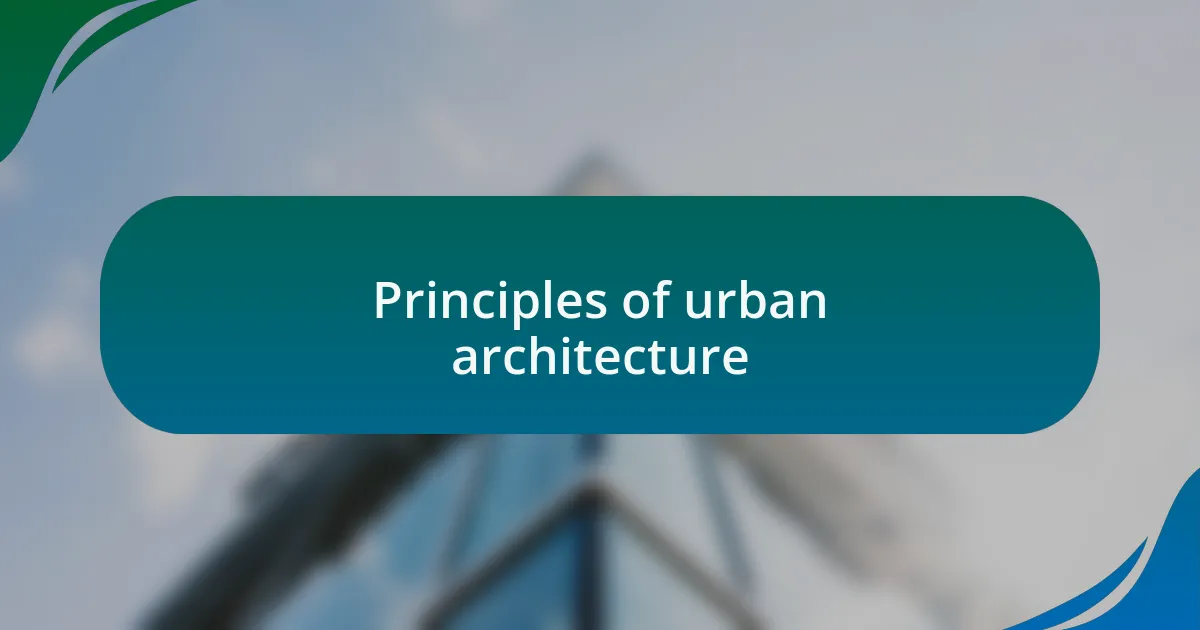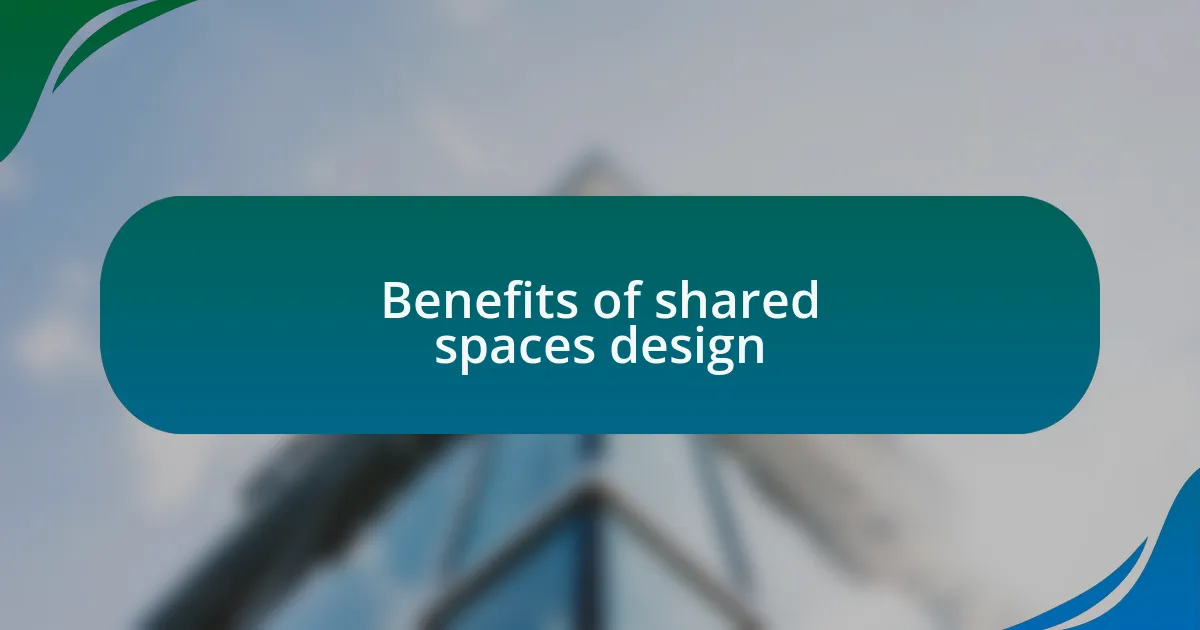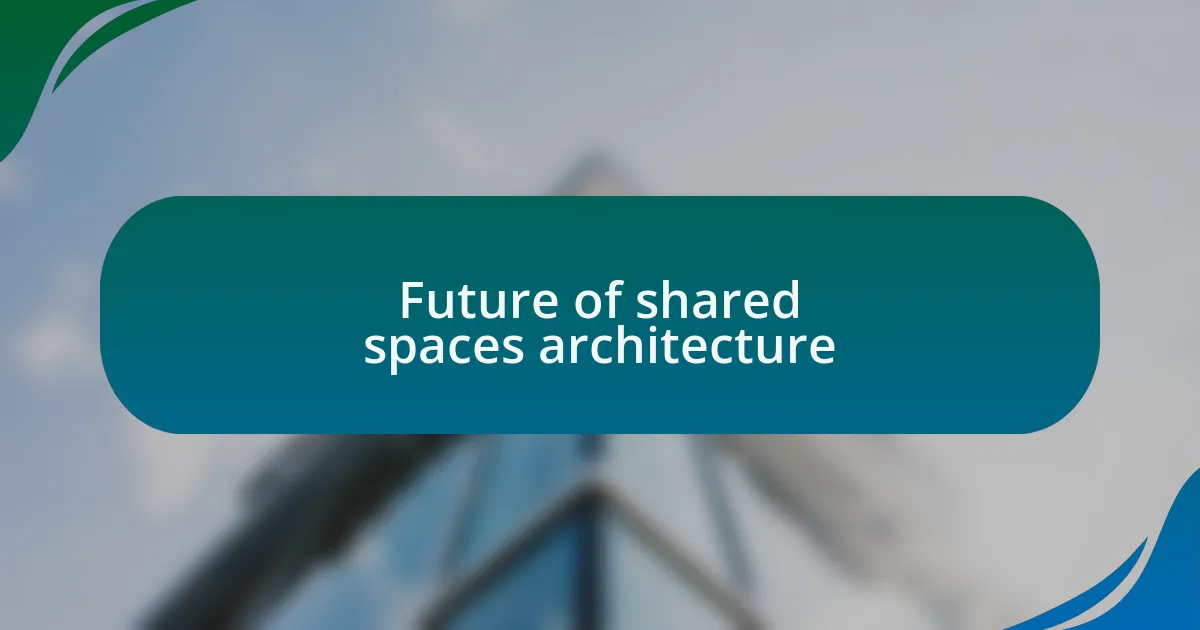Key takeaways:
- Shared spaces theory promotes Human-centered design, prioritizing pedestrian experiences over vehicle dominance.
- Key principles in urban architecture include fostering human interaction, contextual sensitivity, and adaptability in design.
- Benefits of shared spaces include enhanced social interaction, sustainability, and economic development through foot traffic.
- Future shared spaces will be more adaptable, technologically integrated, and focused on sustainability to meet community needs.

Understanding shared spaces theory
The concept of shared spaces theory revolves around the idea of eliminating traditional barriers between pedestrians and vehicles, creating an environment where these different forms of transit coexist. I remember my first experience in a shared space in a bustling urban area; it was fascinating to see how people adapted, showcasing a newfound sense of awareness and interaction. How often do we overlook the dynamics of our urban environments and the potential for a more harmonious coexistence?
This theory emphasizes human-centered design, focusing on the individual’s experience rather than vehicular dominance. I often think back to a weekend road trip where we explored a city rich in shared spaces, reveling in how vibrant and inviting the atmosphere felt. It struck me how a simple change in design can elevate daily interactions and create a more cohesive community feel.
Moreover, shared spaces can foster social interactions that are often missing in conventional urban layouts. Just recently, I watched a group of children play near a café, their laughter mingling with conversations from passersby. This scene made me ponder—could shared spaces be the key to rebuilding a sense of community that seems to be fading in our highly structured urban landscapes?

Principles of urban architecture
In urban architecture, one of the fundamental principles is creating spaces that prioritize human interaction over vehicle circulation. I recall visiting a city park designed with this principle in mind; the layout encouraged conversations among visitors while minimizing the presence of cars. It made me wonder, how often do architects consider the social fabric of a place when designing urban spaces?
Another key principle is contextual sensitivity, where design responds to the surrounding environment and culture. I remember walking through a neighborhood where the buildings reflected local traditions and materials, creating a sense of belonging. It’s essential to ask ourselves: what stories do our urban landscapes tell, and how can we design spaces that enrich those narratives?
Lastly, adaptability plays a crucial role in urban architecture. Observing a space that transforms throughout the day—from a bustling market in the morning to a quiet gathering spot in the evening—highlighted how design can accommodate various uses and promote inclusivity. Is it possible for us to harness this flexibility to ensure our urban areas evolve with the needs of their communities?

Benefits of shared spaces design
One major benefit of shared space design is increased social interaction. I recall a vibrant plaza where people from diverse backgrounds congregated—kids playing, families picnicking, and seniors chatting. It struck me how a well-designed shared space cultivates community connections that enrich lives. Have you ever noticed how certain spaces invite people in, while others push them away?
Another advantage is the promotion of sustainability. When spaces are designed to be shared, it often means fewer resources are consumed. I once visited a neighborhood that replaced a parking lot with a garden and public seating, transforming an underutilized area into a green oasis. It made me feel hopeful about urban environments that prioritize eco-friendly practices, making them not only livable but also thriving.
Finally, shared spaces can enhance economic development. I’ve seen local businesses thrive in areas with pedestrian-friendly designs, drawing in foot traffic that supports shops and cafes. Wouldn’t it be great if every urban center recognized this potential and intentionally fostered environments where commerce and community walk side by side?

My experiences with shared spaces
The first time I encountered a shared space, it was in a bustling market square. The energy was palpable, with street performers, local vendors, and visitors all weaving together in this vibrant tapestry. I remember feeling a sense of belonging, as if I was part of something larger than myself—how often do we get that in our busy lives?
In another instance, while visiting a city that embraced shared spaces, I lingered in a park designed for both relaxation and play. Watching parents engage with their children while sitting on benches right next to a community art installation struck a chord with me. Isn’t it fascinating how a well-thought-out design can encourage such organic interactions?
I’ve also witnessed the challenges of poorly designed shared spaces. In one neighborhood, a once-popular plaza had become neglected and uninviting. It was disheartening to see potential go to waste, reminding me how essential thoughtful planning is for nurturing community spirit. Have you ever felt that sense of loss when a space you loved starts to fade away?

Case studies in shared spaces
One standout example of a successful shared space is the High Line in New York City. I remember strolling along this elevated park, transformed from an old rail line. The vibrant gardens, art installations, and varied seating areas foster a deep sense of community, making it a welcoming haven amidst the urban hustle. How amazing is it to see nature harmonizing with urban life?
In Melbourne, I experienced the power of shared spaces in the laneways. These alleys, once overlooked, are now bustling with cafes and street art. I felt a thrill walking through them, as people congregated to enjoy both food and culture. It’s incredible how a simple change in perspective can turn forgotten spaces into lively centers of interaction—don’t we all crave that connection?
Conversely, take a look at a city that attempted to create a shared space without genuine community input. In a recent renovation, a city plaza was designed, but it ended up alienating the very residents it was meant to serve. I walked through it and felt an unsettling emptiness; it was a stark reminder of how crucial it is to engage with local voices during the planning process. How often do planners overlook the people who truly know these spaces best?

Future of shared spaces architecture
As I look ahead to the future of shared spaces architecture, I envision environments that are even more adaptable and responsive to community needs. Imagine parks and plazas that can transform based on events or seasons—one day serving as a marketplace, the next as an open-air theater. How empowering would it be for residents to have spaces that evolve in real-time with their desires?
I also believe technology will play a crucial role in shaping these areas. The integration of smart technology can allow for dynamic lighting, sustainable energy sources, and even interactive art installations. I remember visiting a tech-driven plaza where augmented reality features made the art come alive. It drew people together, creating a shared experience that felt fresh and exciting. Can technology bridge gaps in connectivity among diverse groups?
Moreover, I see a strong emphasis on sustainability guiding the design of shared spaces. Architects will prioritize materials that are eco-friendly and designs that encourage biodiversity, like rooftop gardens or vertical green walls. During my travels, I’ve seen how green spaces can enhance mental well-being, and I wonder—if more communities embraced this, how much richer could urban life become?